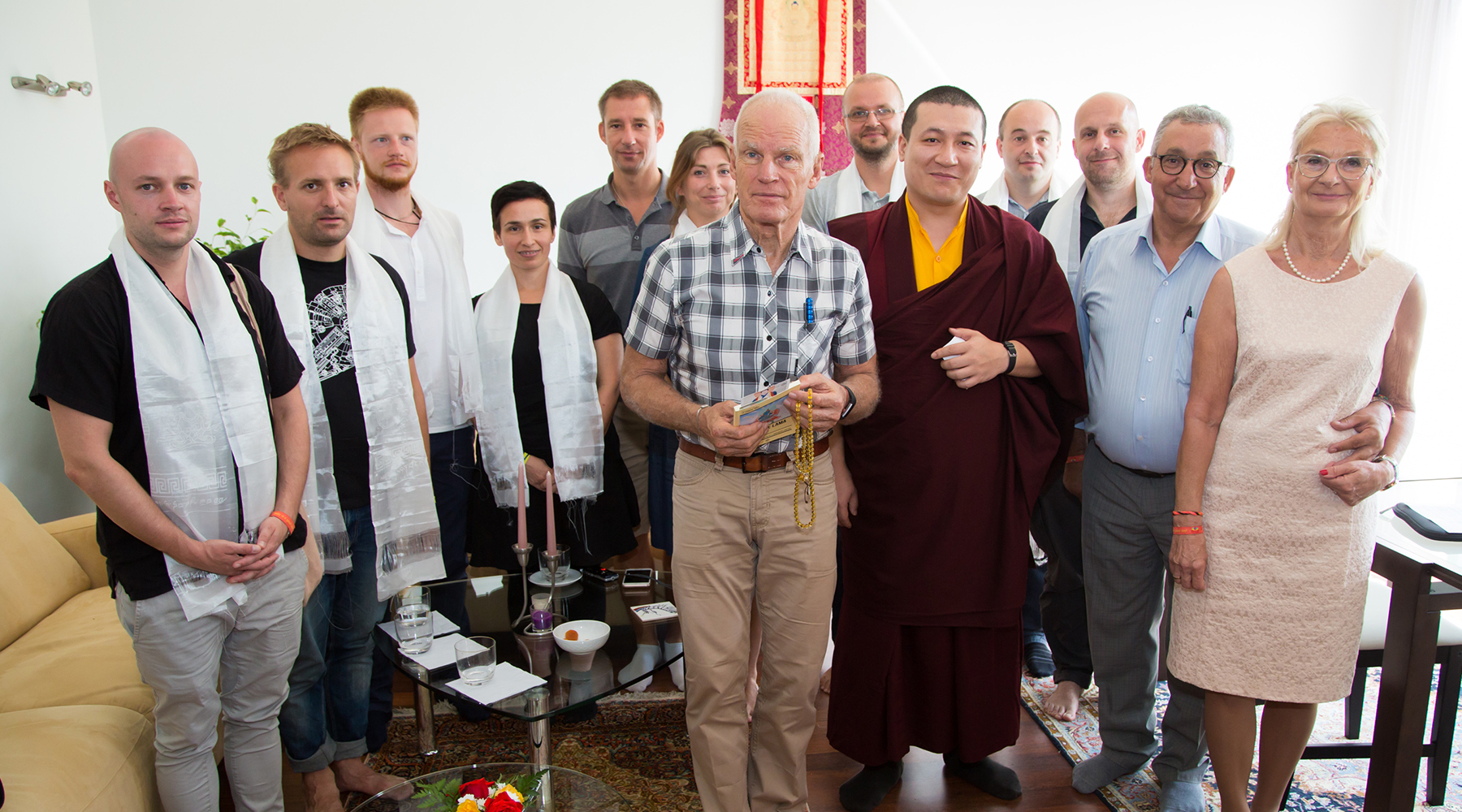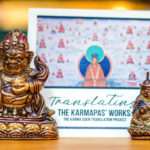The inauguration of the ITAS “Translating the Works of the Karmapas” project and meeting with His Holiness the 17th Karmapa and Lama Ole Nydahl
“Be on your toes.” – Karmapa, Karma Guen, 20 August 2017
The “Translating the Works of the Karmapas” project
The ITAS translation project was created with the aim of preserving the teachings of the Karma Kagyü masters, enabling the transfer of knowledge and understanding of dharma teachings to the West, and making them accessible to a wider group of practitioners.
The project is the continuation of Hannah Nydahl’s vision and wishes and has had strong support from Karmapa, Lama Ole, Pedro and Dorrit, who jointly oversee the ongoing activities. Dorrit and Pedro Gomez have been Lama Ole’s students since the beginning of the Diamond Way Karma Kagyü School in the West and established the Foundation which governs the Karma Guen retreat centre. The Foundation follows the structure of other Diamond Way Foundations, being chaired by His Holiness the 17th Karmapa and Lama Ole Nydahl. Dorrit and Pedro Gomez and one representative from the German Stiftung organisation, currently Tomek Lehnert, are also chairs. The Foundation is the driving force behind the current translation project.
The translation team is a group of highly dedicated colleagues, specialists and practitioners with wide experience in Tibetan and Sanskrit languages, Buddhist philosophy, Tibetan culture, and translation. Many of them have completed the ITAS Tibetan language course in Karma Guen and KIBI and now teach at these institutions.
The work on the project started a while back. The initial step was to collect all the titles of all the Karmapas’ books and works and to catalogue and prepare them for translation. For example, the team prepared the translation of all the titles, most of which is already available on the website (www.translating-karmapas.org).
Inaugural meeting with the 17th Karmapa and Lama Ole
The team met with Karmapa and Lama Ole in Karma Guen on the day of the official inauguration of the ITAS building and the Rangjung Dawa art school.
The meeting was an opportunity for the team to understand Karmapa’s vision for the project. This included both the high level direction and how the project would fit with similar activities taking place elsewhere, as well as practical questions regarding the choice of texts to translate and ways of working together. With Lama Ole and Pedro also present, the team was able to get support and clear steering on how to ensure that the work carried out as part of the project will bring benefit and convey the dharma teachings in the most appropriate way.
The meeting was followed by an official inauguration ceremony attended by the Minister of Education and representatives from the University of Malaga.
“The only thing I can say is practice”
During the meeting Karmapa stressed the importance of this work. With Buddhist philosophy spreading around the world within the last half a century, there is an increasing need to make Buddhist teachings accessible to a wider population and in many different languages. At the same time, Karmapa pointed out the incredibly challenging nature of the task and the great responsibility related to translating the teachings to be used by practitioners worldwide. He expressed the view that translating is not only a question of understanding the language, but also of understanding the mentality, culture and concepts included in the original text. This, according to Karmapa, is particularly the case when translating the teachings of realised beings that enable us to get a glimpse of their state of mind. In order to truly and accurately translate such texts, the translator needs more than just the factual side and theoretical concepts. As such, in order for the translator to have a direct connection to the teachings and to translate from the heart, Karmapa stressed the importance of practice. Practice is necessary to convey the Buddha-dharma in an understandable and user-friendly way to various languages and cultures.
This is key when working with a multi-layered and highly contextual language such as Tibetan. Karmapa highlighted the risk of limiting the interpretations and meanings of some Tibetan terms to only one foreign language equivalent and hence narrowing and overly simplifying the understanding of the texts.
The selection of texts and the establishment of official exchange with Kalimpong
From the vast list of titles Karmapa selected two texts from the Third Karmapa to be translated first:
- Treatise Illuminating the Sutra Called “Establishing Mindfulness on the Genuine Dharma”
- Commentary on the Treatise Illuminating the Sutra Called “Establishing Mindfulness on the Genuine Dharma”
In addition, he asked the team to study and work on a commentary text on Tibetan grammar which will enable a deeper understanding of the Tibetan culture and language and support the translation of dharma texts. This is particularly important as Tibetan grammar is not often studied at Western universities .
Karmapa expressed a strong wish that the work within this project be done in cooperation with and parallel to the translation work in Kalimpong. The Kalimpong Shedra, Karmapa’s main institute for higher monastic studies, publishes collections and commentaries on various topics in the Tibetan language. To support that collaboration Karmapa suggested an exchange programme with Kalimpong whereby different Khenpos who graduated from Kalimpong’s programme would establish a rotation system of working with the ITAS team. This would enable an exchange of views on the interpretation of the texts, help the team to gain a deeper understanding of the Tibetan language and meaning of the texts, as well as build a strong connection between the various groups in the two institutes to ensure the proper transmission of the teachings.
The way forward
The team discussed the ways of working together going forward with Lama Ole and Karmapa. Lama Ole stressed the importance of undertaking this project as a group of friends with strong connections and life experiences. He spoke of the benefits of working together and not being afraid to challenge each other in terms of meaning or to clarify the message of the translated texts. He also asked the team to keep in mind that the work is done for the benefit of others and expressed the need to keep things fresh and full of inspiration. He suggested that the team work closely with Dorrit and Pedro, running things by them whenever possible to ensure clarity of vision. Lama Ole also further mentioned that he himself has sent many bright minds to study and translate at ITAS.
Besides the main translation project starting in Karma Guen, the ITAS team continues to offer educational courses in Classical Tibetan for those interested in Tibetan language. A new group of 15 students started in 2017 with Classical Tibetan I course and will continue in 2018 with two further courses.
Next steps
Up until December 2017, the translation team had been preparing the preliminary research of the chosen texts and putting together a working plan for the next two years. Representatives of the Karma Guen foundation and ITAS team will meet His Holiness Karmapa in Bodhgaya during the annual Kagyü Monlam to discuss plans and processes. Moreover, the cooperation with khenpos from the Kalimpong Shedra will be initiated, according to Karmapa’s wishes.
If you would like to know more about the Karmapas’ collection and the ways in which you can support the project, please visit www.translating-karmapas.org


